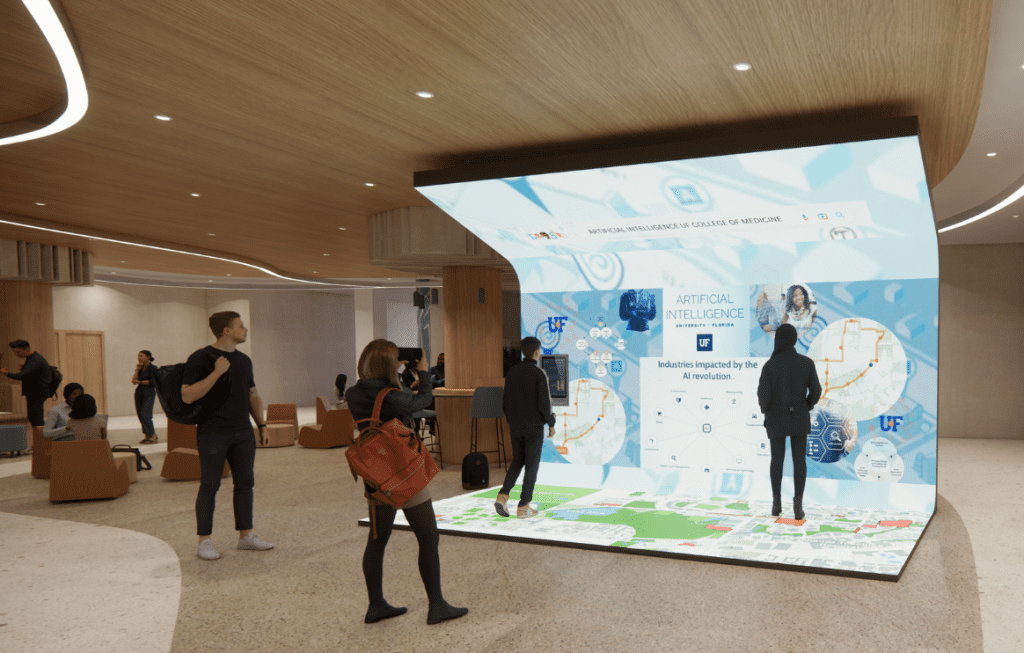By: Kyle Niblett
December 9, 2022

As the campus focal point for artificial intelligence at the University of Florida, the soon-to-be-built Artificial Intelligence Academic Initiative Center (AI² Center) will create a larger and much broader ecosystem of space that connects UF’s preeminence in AI-related higher education with the student body and public. With this in mind, Associate Provost for Strategic Initiatives and AI² Center Inaugural Director Dr. David Reed challenged UF College of Design, Construction and Planning students from the Department of Interior Design to create the space.
“The creativity and hard work of these students was plainly evident in their projects,” Reed said. “They made an enormous contribution to the future vision of AI at UF and the type of space we hope to build someday. The AI community at UF will benefit from their inspiring work.”
Surrounded by their peers, professors, and Reed himself, interior design students rose to the challenge December 7 with breathtaking project presentations that showcased an “AI for All” mentality and addressed the diversity of such an elite space. Sorted into groups of five, design studios taught by Associate Professor Jason Meneely and Instructional Assistant Professor Genesis Okken formed teams for their final project of the semester. Each team was tasked with six specific design drivers: branded environment, active learning, blended learning, a space supporting rhythm of learning, working, and playing, wellbeing and palette of place.

“Our goal at UF is to create an AI curriculum so valuable that other institutions of higher learning will ask us for our playbook,” Okken said. “Right now, it is all very segmented with no central hub, so we tasked our students to design concepts for the upcoming AI² Center that acts as an interdisciplinary home base for integrating the AI way on campus.”
While some of the students entered the project unfamiliar with how artificial intelligence could impact their own design process, all five groups exit campus for Christmas break with a deeper understanding of how AI can be integrated into their future careers. Many students commented on how they feared daunting zeros and ones followed by decimal points, but quickly learned through their work that AI is treated as very human scale and practical.
“The AI curriculum taught to us by our professors has already pushed our education forward,” said junior Olivia Cederquist, an interior design major who participated in the project. “With everything in our world getting more technical and digital by the day, we found out this semester UF’s AI initiative will set us up for immediate success when we graduate. It is not the way of the future; it is the way of the present.”
Instead of the AI stereotypes of a mind map or a chart of numbers, DCP students humanized AI to people such as AI² Center Project Manager Mackenzie Donovan and OEC Business Interiors Account Executive Brenda Wawers by showcasing interactive and collaborative suites for the faculty and touchdown areas for interns. A concurrent theme were active learning classrooms with movable furniture and portable writing surfaces that provided the utmost flexibility.
“Our goal in the design of this project was to create a visual experience that would balance the stimulating nature of AI with a peaceful and biophilic approach,” junior interior design major Isabella Leon said. “This would in-turn create a sort of comfortable curiosity within the human experiencing it.”
What made the final projects even more impressive was the fact that this was each student’s first group project. Instead of getting stuck in their own mind creatively, they were pushed by their colleagues to think outside their comfort zone and cycle through multiple concepts. With group members being delegated to certain areas such as ceilings or lighting for the space, the project took multiple weeks to finish, including Zoom meetings over Thanksgiving break and late-night coffee runs between studio sessions in the days leading up to the presentations.
“It was inspiring to see everyone’s concepts because despite having similar elements, the concepts, palette colors and ideas were so strong and different,” Cederquist explained. “Whoever designs this space will have a lot of ideas to pull from today and I could not be prouder of my teammates.”
From designing employee workspaces to accounting for future growth and non-territorial spaces, the students consistently refined an iterative, time-consuming process. Dealing with different perspectives, different work ethics and different ways of working could have caused a trainwreck design-wise, but members of UF’s academic community walked away impressed.
“Our students are one of the biggest reasons why we’re a top-five university, so I wasn’t shocked or surprised by their outstanding quality of work today,” Meneely said. “I am so proud of them.”